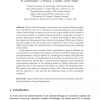Free Online Productivity Tools
i2Speak
i2Symbol
i2OCR
iTex2Img
iWeb2Print
iWeb2Shot
i2Type
iPdf2Split
iPdf2Merge
i2Bopomofo
i2Arabic
i2Style
i2Image
i2PDF
iLatex2Rtf
Sci2ools
EUROMED
2010
2010
Same Same But Different - Comparing Rendering Environments for Interactive Digital Objects
Digital cultural heritage in interactive form can take different shapes. It can be either in the form of interactive virtual representations of non-digital objects like buildings or nature, but also as born digital materials like interactive art and video games. To preserve these materials for a long term, we need to perform preservation actions on them. To check the validity of these actions, the original and the preserved form have to be compared. While static information like images or text documents can be migrated to new formats, especially digital objects which are interactive have to be preserved using new rendering environments. In this paper we show how the results of rendering an object in different environments can be compared. We present a workflow with three stages that supports the execution of digital objects in a rendering environment, the application of interactive actions in a standardized way to ensure no deviations due to different interactions, and the XCL Layout p...
| Added | 25 Jan 2011 |
| Updated | 25 Jan 2011 |
| Type | Journal |
| Year | 2010 |
| Where | EUROMED |
| Authors | Mark Guttenbrunner, J. Wieners, Andreas Rauber, Manfred Thaller |
Comments (0)

